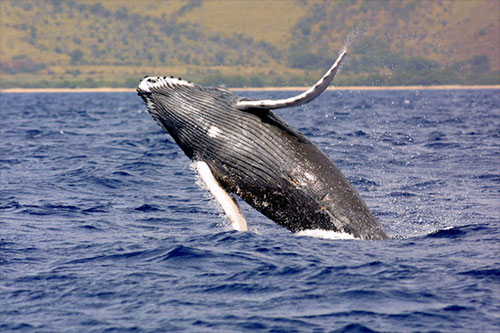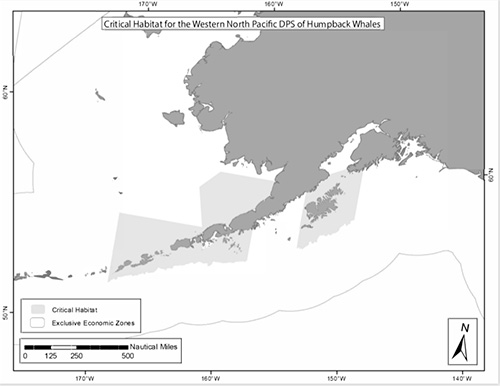
Federal Rule Proposed to Protect Pacific Humpback Whale Critical HabitatEndangered Whales Threatened by Fishing Gear, Vessel Strikes Habitat ImpactsBy MARY KAUFFMAN October 12, 2019
NOAA Fisheries propose to designate critical habitat for the endangered Western North Pacific distinct population segment (DPS), the endangered Central America DPS, and the threatened Mexico DPS of humpback whales (Megaptera novaeangliae) pursuant to section 4 of the Endangered Species Act (ESA).
The areas proposed as critical habitat and/or exclusive econimic zones include specific marine areas located off the coasts of California, Oregon, Washington, and Alaska. Based on consideration of national security and economic impacts, the National Marine Fisheries Services proposed to exclude multiple areas from the designation for each DPS. We are soliciting comments on all aspects of the proposed critical habitat designations and will consider information received prior to making final designations. In Alaska, critical habitats and/or exclusive economic zones are listed in the new rule as Bristol Bay, Lake and Peninsula, Aleutians East, Aleutian West, Kodiak Island, Kenai Peninsula, Valdez- Cordova, Ketchikan Gateway Borough and the unorganized boroughs: Skagway-Hoonah- Angoon, Haines, Juneau, Sitka, Petersburg, and Wrangell. NOAA is soliciting comments on all aspects of the proposed critical habitat designations and will consider information received prior to making final designations. Comment period closes on December 09, 2019. To submit a comment online, click here. According to NOAA, before a moratorium on commercial whaling in 1985, all populations of humpback whales were greatly reduced, some by more than 95 percent. The species is now increasing in abundance in much of its range, but still faces threats from entanglement in fishing gear, vessel strikes, vessel-based harassment, underwater noise, and habitat impacts. The announcement by the National Marine Fisheries Service follows a court-approved agreement in August 2018 with the Center for Biological Diversity, Turtle Island Restoration Network and Wishtoyo Foundation to issue new protections. The groups had sued the Trump administration for failing to protect two Pacific Ocean humpback populations listed as endangered and a third as threatened under the Endangered Species Act.
“Pacific humpback whales will be safer in their ocean home with these protections,” said Catherine Kilduff, a Center attorney. “Humpbacks delight whale watchers with their antics, but these playful animals are highly vulnerable to human activities in coastal waters. Identifying their critical habitat is an important way to protect them from speeding ships, oil spills and fishing gear.” One population of endangered humpback whales that feeds off California’s coast contains fewer than 800 individuals, meaning that deaths or injuries from entanglement could hurt their recovery. At least 54 humpback whales were found tangled up in fishing gear off the West Coast in 2016. Entanglements cause injuries and death as the ropes cut into animals’ flesh, sap their strength and lead to drowning. “As we have since time immemorial, the indigenous people of coastal California hold a sacred ancestral responsibility to care for our ocean relatives. Their well-being is deeply tied to our own,” said Alicia Cordero, First Nations program officer at Wishtoyo Foundation. “Ensuring the identification of humpback whale critical habitat is an essential step in meeting our cultural mandates and maintaining our traditional lifeways.” The rule designates 48,459 square miles of critical habitat off the coast of California, Oregon and Washington for the humpback population that winters in Central America. The Mexico population got 175,812 square miles in the North Pacific Ocean, including Bristol Bay, Bering Sea and Gulf of Alaska — regions that also made up the 78,690 square miles listed for the Western North Pacific humpback population. According to the Center for Biological Diversity, ship strikes and oil spills are the other major threats to West Coast humpback whales. The Center for Biological Diversity references a study that found that an estimated 22 humpback whales off California, Oregon and Washington die each year after being hit by ships. The Trump administration last year proposed to expand offshoreoil drilling in the Pacific, a plan temporarily suspended earlier in 2019 until after next year’s presidential election. “It is unfortunate that it took legal action against the Trump administration to secure protection for endangered humpback whales, but we are pleased to move forward with our efforts to create additional marine protected areas for threatened marine life,” said Todd Steiner, ecologist and executive director of Turtle Island Restoration Network. Critical habitat protection will help safeguard ocean areas essential for migrating and feeding. The designation will ensure that federally permitted activities do not destroy or harm important whale habitat. Evidence referenced by the Center for Biological Diversity shows that endangered or threatened species that have protected critical habitat are twice as likely to be recovering as those without it. Humpback whale populations that need critical habitat were identified in 2016 by the National Marine Fisheries Service. Those include the threatened Mexico population that feeds off the U.S. West Coast and Alaska, the endangered Central America population that feeds almost exclusively off California and Oregon and the Western North Pacific population that feed
On the Web: National Marine Fisheries Service: Supporting Materials
Source of News:
|
|||||

